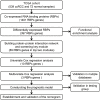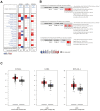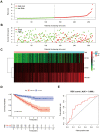Development of prognostic signature based on RNA binding proteins related genes analysis in clear cell renal cell carcinoma
- PMID: 33461173
- PMCID: PMC7906138
- DOI: 10.18632/aging.202360
Development of prognostic signature based on RNA binding proteins related genes analysis in clear cell renal cell carcinoma
Abstract
RNA binding proteins (RBPs) play significant roles in the development of tumors. However, a comprehensive analysis of the biological functions of RBPs in clear cell renal cell carcinoma (ccRCC) has not been performed. Our study aimed to construct an RBP-related risk model for prognosis prediction in ccRCC patients. First, RNA sequencing data of ccRCC were downloaded from The Cancer Genome Atlas (TCGA) database. Three RBP genes (EIF4A1, CARS, and RPL22L1) were validated as prognosis-related hub genes by univariate and multivariate Cox regression analyses and were integrated into a prognostic model by least absolute shrinkage and selection operator (LASSO) Cox regression analysis. According to this model, patients with high risk scores displayed significantly worse overall survival (OS) than those with low risk scores. Moreover, the multivariate Cox analysis results indicated that risk score, tumor grade, and tumor stage were significantly correlated with patient OS. A nomogram was constructed based on the three RBP genes and showed a good ability to predict outcomes in ccRCC patients. In conclusion, this study identified a three-RBP gene risk model for predicting the prognosis of patients, which is conducive to the identification of novel diagnostic and prognostic molecular markers.
Keywords: RNA binding proteins; biomarker; clear cell renal cell carcinoma; prognostic model.
Conflict of interest statement
Figures












Similar articles
-
A novel 10 glycolysis-related genes signature could predict overall survival for clear cell renal cell carcinoma.BMC Cancer. 2021 Apr 9;21(1):381. doi: 10.1186/s12885-021-08111-0. BMC Cancer. 2021. PMID: 33836688 Free PMC article.
-
Identification of a novel PANoptosis-related gene signature for predicting the prognosis in clear cell renal cell carcinoma.Medicine (Baltimore). 2024 Sep 27;103(39):e39874. doi: 10.1097/MD.0000000000039874. Medicine (Baltimore). 2024. PMID: 39331898 Free PMC article.
-
Prediction of overall survival based upon a new ferroptosis-related gene signature in patients with clear cell renal cell carcinoma.World J Surg Oncol. 2022 Apr 14;20(1):120. doi: 10.1186/s12957-022-02555-9. World J Surg Oncol. 2022. PMID: 35422048 Free PMC article.
-
Profiles of overall survival-related gene expression-based risk signature and their prognostic implications in clear cell renal cell carcinoma.Biosci Rep. 2020 Sep 30;40(9):BSR20200492. doi: 10.1042/BSR20200492. Biosci Rep. 2020. PMID: 32789468 Free PMC article.
-
Signature constructed by glycolysis-immune-related genes can predict the prognosis of osteosarcoma patients.Invest New Drugs. 2022 Aug;40(4):818-830. doi: 10.1007/s10637-022-01228-4. Epub 2022 Apr 18. Invest New Drugs. 2022. PMID: 35435626 Review.
Cited by
-
Ribosomal protein L22-like1 (RPL22L1) mediates sorafenib sensitivity via ERK in hepatocellular carcinoma.Cell Death Discov. 2022 Aug 17;8(1):365. doi: 10.1038/s41420-022-01153-8. Cell Death Discov. 2022. PMID: 35973992 Free PMC article.
-
APOBEC3C-mediated NF-κB activation enhances clear cell renal cell carcinoma progression.Mol Oncol. 2025 Jan;19(1):114-132. doi: 10.1002/1878-0261.13721. Epub 2024 Aug 26. Mol Oncol. 2025. PMID: 39183666 Free PMC article.
-
Transcription of the Envelope Protein by 1-L Protein-RNA Recognition Code Leads to Genes/Proteins That Are Relevant to the SARS-CoV-2 Life Cycle and Pathogenesis.Curr Issues Mol Biol. 2022 Feb 6;44(2):791-816. doi: 10.3390/cimb44020055. Curr Issues Mol Biol. 2022. PMID: 35723340 Free PMC article.
-
Construction and validation of a prognostic model of RNA binding proteins in clear cell renal carcinoma.BMC Nephrol. 2022 May 5;23(1):172. doi: 10.1186/s12882-022-02801-y. BMC Nephrol. 2022. PMID: 35513791 Free PMC article.
-
Novel Molecular Subtypes and Related Score Based on Histone Acetylation Modification in Renal Clear Cell Carcinoma.Front Cell Dev Biol. 2021 Sep 23;9:668810. doi: 10.3389/fcell.2021.668810. eCollection 2021. Front Cell Dev Biol. 2021. PMID: 34631694 Free PMC article.
References
Publication types
MeSH terms
Substances
LinkOut - more resources
Full Text Sources
Other Literature Sources
Medical
Miscellaneous

